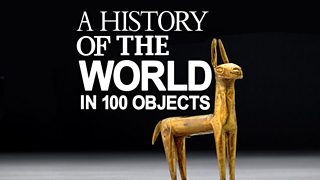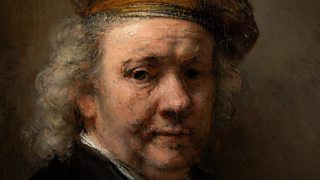Behold the man! Good Friday reflections on a Rembrandt
Rembrandt's Ecco homo (1634) was almost certainly intended to serve for an engraving, for private meditation at home.
In good Dutch Protestant fashion, it closely follows the text of John's Gospel – the clock at the sixth hour, the rabble shouting that they have no king but Caesar.
As onlookers, it forces us to confront the question, Who is this man? Is he a king? and if so, what kind of king? Neil MacGregor reflects on one of the National Gallery's most important paintings.

Neil MacGregor was director of the National Gallery from (1987-2002) and the British Museum (2002-2015).
He is currently the founding director of the Humboldt Forum in Berlin.
He was the author of A History of the World in 100 Objects, a joint project of 大象传媒 Radio 4 and the British Museum.
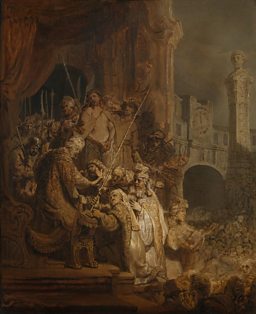
We are in the National Gallery in London, standing in front of Rembrandt’s Good Friday meditation – Ecce Homo. Pilate, the Roman governor, is presenting Jesus to the crowd for the second time; earlier, he had brought him out and said simply, "Behold the man!" – now, he dramatically raises the stakes. Pilate has just questioned Jesus carefully in private, and has at last made up his mind about who this man is – and, as he’s a diligent imperial administrator, he will in a few minutes make sure that he writes it down, on the notice that will be put on the cross. He has come to the conclusion that Jesus of Nazareth is the King of the Jews.
It’s a small picture, roughly twice the size of a sheet of A4 paper, and it’s painted on paper, in oils. It’s almost entirely in browns and greys and whites, because it was made as a preparatory study for a black-and-white etching, which was produced shortly afterwards, and turned out to be extremely popular. Indeed, if you look at this picture in a certain light, you can see that the outlines have been gone over with a stylus, to transfer them to the copper plate for the etcher to work on.
So this is not official religious art, commissioned and approved by a particular church. It’s very much a private image, intended to be looked at closely, to be bought in the market place or the print shop, and taken home, where you ponder what it means for you there, in your daily life. And the more I look at it, the more disturbing I find this image becomes.
Rembrandt follows John’s text very closely. The left half of the picture shows a grand official building, the governor’s palace, with a large stone terrace in front of it at first-storey level.
Here, nearest to us, is Pilate, splendidly robed and turbaned, as you’d expect of the emperor’s representative, shown in his place on the judgment seat mentioned in the text – a kind of low throne.
Above him is a canopy, emblem of imperial authority, and its drapery provides the only colour in the whole composition: a dull blood red. Kneeling in front of Pilate, and clearly vigorously arguing with him, are the chief priests, also sumptuously robed.
Above and behind them, we see what they are arguing about: on a step in the centre of the Pavement, and the highest figure on it, is Jesus.
Unlike the figures below, he is almost naked, except for the mocking robe and crown of thorns. He is handcuffed, surrounded and jostled by soldiers carrying pikes, and standing quite still, looking out at us.
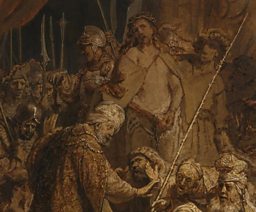
On the right hand side, below the platform, we look down to the city gate and the shadowy square in front of it, packed to overflowing with a large crowd. All we can see of the people there is a multitude of sketchily painted heads, crammed close together, with no discernible features.
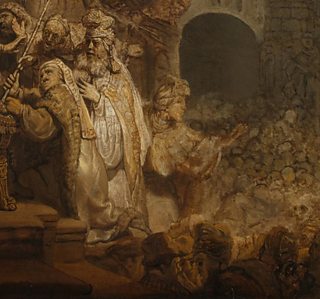
This is literally a faceless mob, but Rembrandt, by repeating the curving rhythms of the anonymous, amorphous heads, suggests a suppressed violence that could at any moment explode into riot.
This crowd, we sense, is dangerous. This is a twitter storm waiting to break, about to turn into very ugly action on the street.
Now a figure on the platform gestures to them to hush, and they look up, watching, waiting, as their religious leaders insistently hold out to Pilate the long rod of justice which he must take in order to pronounce the sentence of death on Jesus.
But Pilate, for the moment, refuses to take it, and asks one last question: "Shall I crucify your king?" ‘The chief priests answered, “We have no king but Caesar.”
At this point, we notice the top right hand quarter of the painting. There, on a tall column in the city square, is Caesar himself – or at least an over- life-size bust of the Roman emperor, whose troops occupy the country and control the city, wearing round his shoulders a military commander’s cloak, and on his head the laurel wreath of victory in battle.
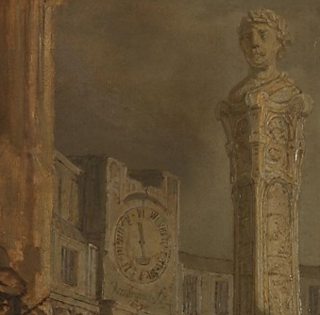
Like Jesus on the other side of the picture wearing his mock-royal cloak and his crown of thorns, Caesar looks serenely outwards. The two heads echo each other – they’re the highest heads in the whole composition – one in stone, one in flesh; the opposing poles of this drama. Caesar or Jesus? The might of the Roman legions, or the refusal of all force? The security of power and the established order, or the powerlessness of humility and love, with its unavoidable suffering? Between these two figures, we have to choose.
Most painters tackling this subject ask us to focus on the suffering which Jesus has already endured and will now undergo on the cross. To contemplate the distress of Jesus, fearful and alone, abandoned by the friends who had promised to stay with him, watching the crowd which a week before had saluted him as their King, now rabidly shouting for him to be killed.
Rembrandt does that, of course, but he asks us to do something more – and something much more demanding: to empathise with each of the human actors here, to feel what they are feeling, to notice how they all try to avoid taking final responsibility – and to find in them part of ourselves.
We can all imagine what it is to be Pilate at this moment. He’s not a Jew, and he is responsible for public order: he doesn’t want to risk a riot that could easily get out of control, and might well cost him his career – as well as leaving many dead. So, although he feels bad about it, he does what he knows to be wrong, and gives the priests and the crowd what they are clamouring for. In a minute he will take the rod of justice, to commit what he knows to be an injustice. Jesus will be marched out through the city gate that we can see below, and led to Calvary.
We have all been that crowd in front of the city gate, part of a group as fickle as this one, and as easily persuaded into quick judgments and simple solutions which will, once and for all –we are told, and for a moment we believe -- get rid of the problem. They (whoever they are) will have to sort this out.
We are also – all of us – the priests. We want somebody else to do the dirty work for us. We cling to the certainties and the habits that have shaped how we order our life. We lack the humility, and perhaps even more the courage, to start re-thinking from the beginning what God’s purpose, God’s mercy and love, really mean for us now.
But that is what Jesus has asked: that we dismantle the structures we have erected, in religion and in politics, to limit the scope of God’s love; and to look at how our behaviour every day disowns and dishonours it.
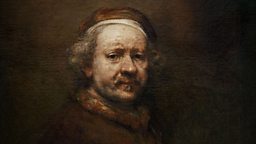

-
![]()
Good Friday Meditation: Behold the Man!
At the hour when Christians contemplate Christ's death, Neil MacGregor and the Rev Lucy Winkett stand before one of Rembrandt's masterpieces, Ecce Homo, in the National Gallery.
-
![]()
Sunday Worship
The Most Revd Justin Welby shares his Easter message of hope and resurrection, in a joyful celebration, live from Canterbury Cathedral.
-
![]()
A History of the World in 100 Objects
Neil MacGregor narrates 100 programmes that retell humanity's history through the objects we have made.
-
![]()
Great Lives: Rembrandt
Artist and sculptor Maggi Hambling nominates Rembrandt as her choice of a great life.


